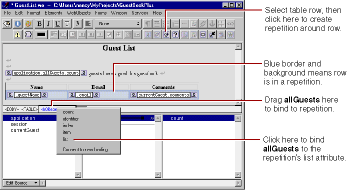Using a Repetition
Now you'll create a table to display the entire list of guests in the GuestList component. To do so, you'll use a dynamic element called a repetition (an instance of the WORepetition class). Repetitions are one of the most important elements in WebObjects, since it is quite common for applications to display repeated data (often from databases) when the amount of data to be displayed isn't known until runtime. Typically, a repetition is used to generate items in a list or a browser, multiple rows in a table, or multiple tables. A repetition can contain any other elements--either static HTML or dynamic WebObjects elements. In the GuestList component, you'll create a repetition that contains a table row. You'll bind the allGuests array to the WORepetition's list attribute. This tells WebObjects to generate the elements in the repetition once for each item in the array. Each time WebObjects iterates through the array, it sets the repetition's item attribute to the current array object. You bind item to the variable currentGuest and use currentGuest's fields to bind the elements inside the repetition (such as WOStrings). At runtime, the table will consist of one row (displaying name, e-mail address, and comments) for each guest.-
In WebObjects Builder, make the Main component window active (double-click Main.wo).
-
Select the table at the bottom of the page by pressing outside it and dragging across it.
-
Choose Edit
 Copy.
Copy. -
Make the GuestList component active.
-
Place the cursor at the bottom of the page and choose Edit
 Paste.
Paste.You have just copied the table from Main into GuestList. It has all the same properties, including the bindings. The WOStrings in the table are still bound to instance variables of currentGuest. Since currentGuest is a component variable defined in Main, it isn't accessible from GuestList. Therefore, you need to declare it here.
-
From the pull-down list at the bottom of the window, choose Add Key. Enter currentGuest as the name of the variable and Guest as its type, and click Add.
-
Click in one of the cells in the second row. Click <TR> in the path view to select the entire row.

-
Click
 in the toolbar.
in the toolbar.When you wrap a repetition around a table row in this way, the WORepetition symbol
 doesn't appear in the table. Instead, the row appears in blue. For additional examples of using repetitions, see Chapter 3, Creating a WebObjects Database Application
.
doesn't appear in the table. Instead, the row appears in blue. For additional examples of using repetitions, see Chapter 3, Creating a WebObjects Database Application
. -
In the object browser, select application in the first column.
-
In the second column, make a connection from allGuests to the <WORepetition> tag in the path view.
-
In the attribute menu that appears, click list. This binds application.allGuests to the WORepetition's list attribute.

-
Bind currentGuest to the repetition's item attribute.
By using the name currentGuest for the item attribute, you are taking advantage of the fact that the strings in your table are already bound to the fields of currentGuest.
You now have finished implementing the repetition. When the table is generated, it will have one row for each item in the allGuests array.
-
Save the GuestList component.
-
Delete the table from the Main component, since you no longer need it.
-
Test your application.
Note: In this case, you don't have to rebuild or relaunch your application in order to test it. Building is required only when you have made changes to Java or Objective-C code. If you modify a component or WebScript code only, the changes take effect even if the application is already running.
-
Try entering data for multiple guests and verifying that each guest appears in the table.
© 1999 Apple Computer, Inc. – (Last Updated 24 Aug 99)